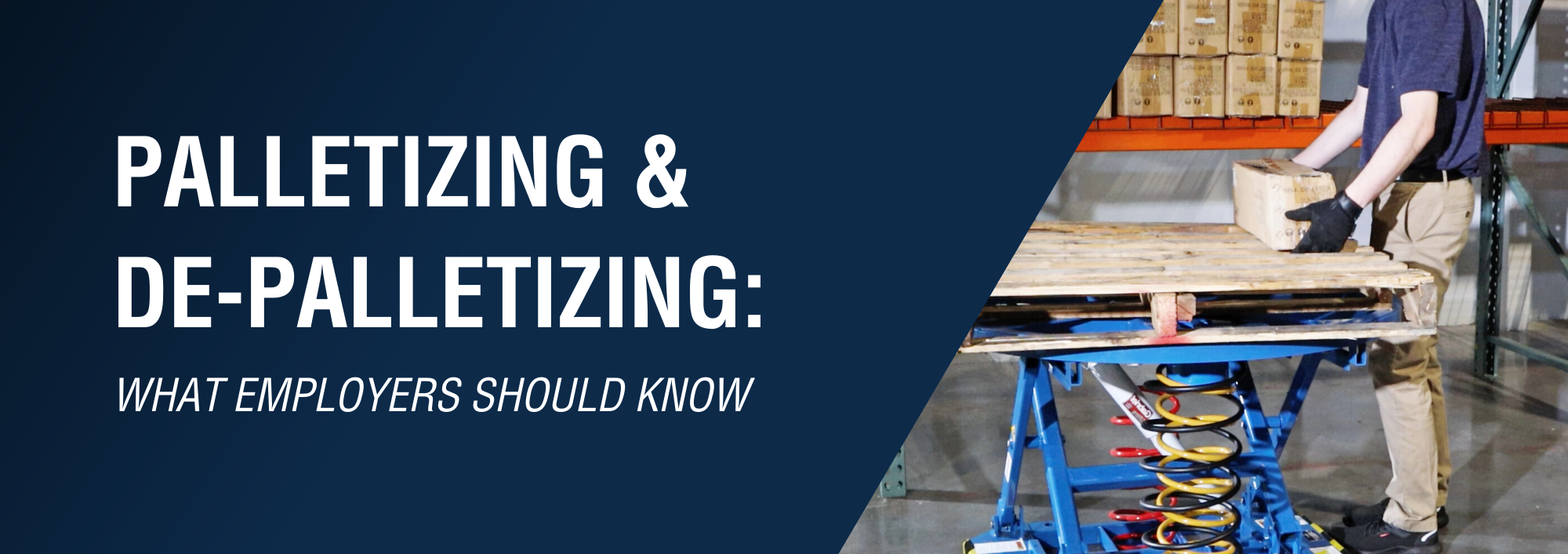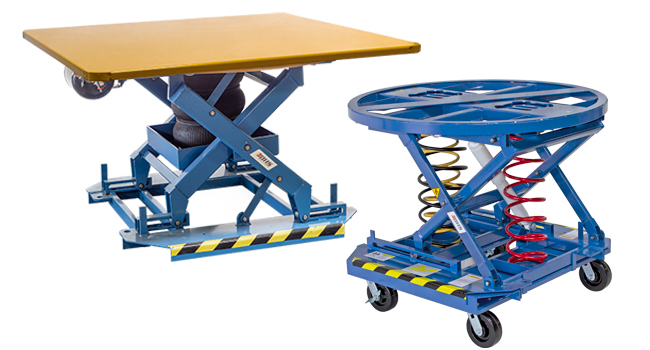We use cookies to make your experience better. To comply with the new e-Privacy directive, we need to ask for your consent to set the cookies. Learn more.
Palletizing and De-palletizing: What Employers Should Know

Pallets are the basic building blocks of the global supply chain. They standardize shipments; they influence the design of material handling equipment; they make it possible to move goods from the manufacturer to the store or the consumer’s doorstep more efficiently. Without pallets, we might not have lift trucks. Without pallets, we might think of “unit loads” in radically different ways.
Because of this centrality to supply chains, workers in the industry spend a lot of time interacting with pallets. Pallet loads must be stacked and secured. Once they arrive at a distribution center or a brick-and-mortar store, items must be removed. We call the act of building a load on a pallet “palletizing.” Removing goods from a pallet is “depalletizing.” These are daily tasks for employees of DCs and stores of all kinds—and they are not without their hazards.
Palletizing, Ergonomics, and Workplace Safety
One out of every three dollars spent on workers’ compensation in the U.S. goes to an employee with a particular type of workplace injury: musculoskeletal disorders, or MSDs. These injuries include sprains, strains, and muscle tears; back pain and neck pain; carpal tunnel syndrome; hernias; and other disorders in the connective tissue, muscles, or bones.
Musculoskeletal disorders are largely caused by repetitive motion, overexertion, and awkward postures—and workplace MSDs are overrepresented in supply chain occupations. In fact, the top jobs for missing workdays due to MSDs in 2018 were laborers and freight, stock, and material movers—the very workers who keep our supply chains running, and who perform frequent palletizing and depalletizing tasks.
Working with pallets can be a risk factor to the development of MSDs, unless the task is approached with proper ergonomics. Ergonomics is the science of matching work to the worker to prevent injury and improve productivity. Here are a few examples of ergonomic interventions that are proven to improve safety on the job:
- Installing variable-height workstations that forego bending and reaching
- The use of material handling equipment to replace manual lifting and carrying
- Rotating workstations to reduce repetitive motions
There are a few bodily movements common to palletizing that lead to poor ergonomics. The Centers for Disease Control and Prevention list MSD-causing exposures as “bending, climbing, crawling, reaching, twisting” and “overexertion or repetitive motion.” Palletizing a unit load by hand typically requires lots of reaching, twisting, and bending. But standard ergonomic interventions may not work for palletizing, which involves a unique challenge: The height of work changes as items are added to or removed from the stack. It’s hard to set a comfortable work height when the goal keeps moving.
Luckily, solutions are available.
Automated Palletizing Vs. Manual Palletizing and De-Palletizing
Today’s supply chains are being transformed by automation. Advances in data science, artificial intelligence, and robotics are creating systems that can palletize boxes with integrated reporting, often as part of broader Industrial Internet of Things (IIoT) initiatives. But even without data-collecting capabilities, automation helps to reduce the risk of developing MSDs.
The National Institute for Occupational Safety and Health (NIOSH) offers a Hierarchy of Controls to illustrate the most effective ways to remove workplace hazards. At the very top is “elimination,” or the physical removal of hazards. If the hazard of palletizing is that workers must reach, stretch, and bend repeatedly to build a pallet-load—or to break one down—then automating all palletizing and depalletizing processes eliminates the risk. It’s a top-tier solution.
These are the three basic types of automated palletizing equipment:
- Layer Palletizers and Depalletizers. These automated palletizers use vacuum grips and/or universal gripping systems to grasp packages one pallet-layer at a time. This is an efficient way to palletizing and depalletize, and universal grips allow these systems to handle a wide variety of materials and packaging shapes.
- Inline Palletizers. Inline palletizing robots are often used in high-throughput packaging lines, like those found in the beverage industry. Robotic arms stand above a mesh-belt conveyor, reaching down to grasp packages with form-fitting grips. The arms move packages from the line onto pallets, arranging them in neat layers.
- Mixed Case Palletizers. Today’s warehouses and distribution centers often handle large numbers of SKUs, each of which may be a different size and shape. That’s been a challenge for palletizing automation, since robots have a harder time with variety. However, recent innovations in computer vision and robotic articulation have led to systems that can lift and layer mixed SKUs on a single pallet.
Of course, not every warehouse or seller can justify the cost of automated palletizing. These systems usually provide workable ROIs in high-throughput environments; for the vast majority of small and medium-sized businesses, palletizing and depalletizing will continue to be done by hand for the foreseeable future—and even facilities outfitted with automated palletizers may still have to construct or unpack some unit loads by hand, since robotic systems tend to be quite rigid in their tasks.
So what can employers do to make manual palletizing and depalletizing safer and more productive? Again, they must remove the hazards.
Key Safety Equipment for Manual Palletizing
The ergonomic hazards of manual palletizing involve the necessity of bending and reaching as the level of work changes. To remove this hazard, employers should provide self-leveling lift tables with rotating tabletops. The Pallet Carousel & Skid Positioner (PCP) from BHS is a perfect example. Available with springs or with pneumatic airbags, these lift tables keep palletizing work at a constant height, even as workers add or remove layers.

The rotating tabletop gives workers access to the opposite side of the pallet load, without having to stretch or reach. Palletizing and depalletizing on a Pallet Carousel & Skid Positioner removes the ergonomic risks associated with the task, improving productivity while reducing workplace hazards. Each unit is available with the end-users choice of tabletop shapes:
- Open Circular Turntable. The standard unit ships with a welded steel, powder-coated circular turntable top that’s ideal for use with all common types of skids and pallets. This tabletop is framed out to reduce weight.
- Solid Steel Carousel. Damaged or unconventionally sized or shaped skids and pallets might get caught on the standard tabletop, so some users choose the solid steel option.
- Solid Stainless Steel Carousel. Food processors, packagers, and sellers may prefer the FDA-compliant stainless steel turntable. It functions just like the Solid Steel Carousel, but instead of powder-coated steel, it’s made entirely from stainless steel.
Regardless of the tabletop style you choose, all Pallet Carousel & Skid Positioners are completely independent of external power sources. The spring tables keep work heights stable with three heavy-duty springs, while pneumatic models can be disconnected from the air source after inflating the 7-ply reinforced rubber airbag. Most important, though, is the automatic work positioning that these units provide. For one example of how to integrate palletizing tables into a workplace, here’s our advice on palletizing in the food and beverage industry.
If you’re in the supply chain, you handle pallets—and if you handle pallets, you need Pallet Carousel & Skid Positioners. Manual palletizing and depalletizing can be tough jobs, but with the right tools and equipment, you can keep them as safe—and as efficient—as possible. For more information about palletizing tables, or to find your nearest BHS dealer, contact our sales team at 1.800.BHS.9500.

